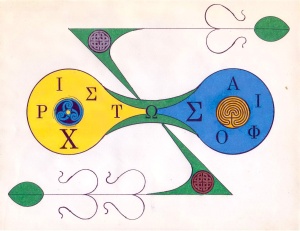During this sacred season of Lent, as Christians prepare inwardly to celebrate the deepest mystery of our faith – the crucifixion and resurrection of Jesus the Christ – I have been meditating upon the vision of Christ on the cross that I described in the previous blog, “Grounded in the Abyss.” I would like to share my reflections because I believe that the archetypal image of the golden Christ has universal meaning.

In this inner vision, Christ on the cross appeared not in the usual image of a dying body but as a figure of brilliant golden light. It reminded me of the “Christus Rex” sculpture that I had seen at Southwell Minster Cathedral in England, which had so impressed me with its radiant beauty and serenity. The body of Jesus the Christ, clothed in dazzling golden robes, hung in perfect balance, with arms outstretched and head and feet vertically aligned. To me the image conveyed the union of the opposites as the crucified Jesus and the resurrected Christ: the transfigured Jesus, the divine being that was hung on the cross of earthly life.
As I meditate further upon this image during Lent, I remember Andrew Harvey’s book Son of Man, in which he describes the life of Christ as the stages of the journey that all Christians must pass through in order to be united with God. Each new stage requires a greater surrender until the process of self-emptying is completed. Embedded in the image of the golden Christ are the three stages that mark the path that Jesus traveled at the end of his life: the Transfiguration, the Crucifixion, and the Resurrection.
 The golden Christ first appeared as an image of the Transfiguration on Mount Tabor, where Jesus’s face shone like the sun and his clothes radiated light. His disciples Peter, John and James were witnesses to this revelation of the Christ, the divine that shone forth in the human Jesus. On the spiritual journey the initial experiences of uniting with the Christ, feeling the light and love of divine life flowing throughout one’s being, signify the inner experience of the Transfiguration as the realization of the divine Self.
The golden Christ first appeared as an image of the Transfiguration on Mount Tabor, where Jesus’s face shone like the sun and his clothes radiated light. His disciples Peter, John and James were witnesses to this revelation of the Christ, the divine that shone forth in the human Jesus. On the spiritual journey the initial experiences of uniting with the Christ, feeling the light and love of divine life flowing throughout one’s being, signify the inner experience of the Transfiguration as the realization of the divine Self.
This transfiguration through union with Christ is beautifully expressed by Simeon the New Theologian, translated by Stephen Mitchell:
We awaken in Christ’s body as Christ awakens our bodies, and my poor hand is Christ, He enters my foot, and is infinitely me. I move my hand, and wonderfully my hand becomes Christ, becomes all of Him (for God is indivisibly whole, seamless in his Godhead.) I move my foot, and at once He appears like a flash of lightning.
Do my words seem blasphemous? Then open your heart to Him and let yourself receive the one who is opening to you so deeply. For if we genuinely love Him we wake up inside Christ’s body where all our body, all over, every most hidden part of it, is realized in joy as Him, and He makes us, utterly, real, and everything that is hurt, everything that seemed to us dark, shameful, maimed, ugly, irreparably damaged, is in Him transformed and recognized as whole, as lovely, and radiant in His light we awaken as the Beloved in every last part of our body.
The physical body, like the ego, is a transient phenomenon of this earthly existence; the “light body” of the true self – represented by the golden Christ – is the undying essence of who we are – timeless and transcendent being. We “awaken as the Beloved,” transfigured in the radiance of His light, through loving union with Christ. Through this transfiguration our awakened eyes see the infinite eternal being that shines forth from every finite human being.

Andrew Harvey extends this image of radiant light in the inner transfiguration through his expression of Christ’s revelation: “my presence in you will flame out and the whole universe will reveal itself as being on fire with me-in-you.” As we awaken to the indwelling Spirit that transfigures our fragile earthly body into the body of Christ, we also realize our union with the entire cosmos. There is ultimately no separation between inner and outer worlds; the human being and all of creation are one in the radiant body of the Cosmic Christ.
But after this nondual realization, the most arduous part of the spiritual journey is still to come. As Harvey says, “the ordeal that follows after the Transfiguration will be the supreme ordeal… now the glory revealed in you in the Transfiguration has to be wedded at every level and in every dimension with the whole of Reality by continuing acts of deepening sacrifice, which culminates in a great death to all human notions of self and identity…” This process of continued surrender becomes the essence of our spiritual journey as the transfiguring union with God becomes stabilized and integrated at every level of our being.
 The Transfiguration therefore is not just one event, but initiates the ongoing process of self-emptying that leads to the Garden of Gethsemane, the trial by which Jesus confronts the last vestiges of self-will based on his human identity. His agony in the Garden prepares Jesus for the final act of surrender that he displays during the Crucifixion. We follow Jesus into the Garden of Gethsemane in our own deepest trials of pain and suffering, in our struggles to finally let go of our ego desires and need to control, freely and fully surrendering to the darkness of not-knowing. This experience of Gethsemane is also for us the threshold to the Crucifixion.
The Transfiguration therefore is not just one event, but initiates the ongoing process of self-emptying that leads to the Garden of Gethsemane, the trial by which Jesus confronts the last vestiges of self-will based on his human identity. His agony in the Garden prepares Jesus for the final act of surrender that he displays during the Crucifixion. We follow Jesus into the Garden of Gethsemane in our own deepest trials of pain and suffering, in our struggles to finally let go of our ego desires and need to control, freely and fully surrendering to the darkness of not-knowing. This experience of Gethsemane is also for us the threshold to the Crucifixion.
In the image of the golden Christ we are reminded that the human Jesus that hung on the cross is also the transfigured Christ. His experience of the depths of human suffering completed the process of total self-emptying that led to his death, but the excruciating agony that Jesus suffered on the cross was due to the death of the self that was united to God. Bernadette Roberts describes this most painful surrender that leads to “no self”: “What Christ gave up on the cross was his divine self, his oneness with God as it was known through the same self-conscious mechanism he shared with us all… at his death he returned to his original way of knowing, the indescribable knowing inherent in the Godhead of absolute Oneness…”
Following the path of Jesus to the Crucifixion also leads to the complete self-emptying: this requires radical trust in God – the divine process that unfolds beyond our conscious will or understanding; radical humility in accepting that our finite human minds can never begin to know the mind of God; radical surrender in accepting whatever comes to us, good or bad, joy or pain; and radical love that holds all suffering within it.
But ultimately to follow Jesus all the way to his death on the cross is the final death of the separate self system – death to not just the ego, but even the true self that is united to Christ yet still perceives as objective observer. As Jesus died on the cross, so we “die” when all the boundaries of self dissolve and we flow into universal Love. This journey beyond the Crucifixion to the Resurrection is the passage beyond the divine self to enter the “Great Flow” that characterizes the existence of “no self” beyond the life of union.

The golden Christ points to this Resurrection as the union of death and new life. As Andrew Harvey says, “Now, in the light of the Resurrection, love’s body is at last complete… You are one flame of the fire that burns in and as all things…” Now, “dead” to the world that we no longer identify with even as we continue to live in it, our “life is hidden with Christ in God.” (Colossians 3:3)
The initial vision of the golden Christ in the Transfiguration is now fulfilled in the Resurrection. Simeon’s experience of transfiguration into Christ’s body is echoed in Andrew Harvey’s vision: “even in the body you have now, love’s body in its glory can appear, and the Resurrection be known and the birthing-in-flame be lived, not totally, but in a luminous shadowing-forth of its ultimate truth.”
Through the image of the golden Christ we can clearly see the true identity of Christ as well as humanity’s potential. The first revelation of the true identity of Christ is given to the three witnesses at the Transfiguration, followed by the complete revelation to his disciples – beginning with Mary Magdalene – at the Resurrection, and will eventually extend to all people. For the vision of the golden Christ is not limited to the Christian religion, but is a symbolic image that reveals wisdom for all of humanity. The recognition of the Universal Christ – in all of the forms by which he/she is known throughout the world – will lead in the fullness of time to the realization of humanity’s sharing in the glory of the golden Christ. The Transfiguration that reveals the new life of divine humanity will lead us from the earthly world of constricted self consciousness into the divine world of unboundaried consciousness. In this Resurrection, we will realize our unity in which there is ultimately no “self” and no “other”: we are one in the Universal Christ who “is all and is in all.” (Colossians 3:11)

Cynthia Avens


On thanksgiving day of 1987 I got lost in the blue ridge mountains of PA. I came across a birdcage beside a river. I placed it into the river thinking I needed to catch a fish to eat. The sky came pressing down and everything became grey and choppy.
I fell to my knees, closed my eyes and prayed to Jesus Christ. When I opened my eyes I saw a Golden Spirit before the tree I prayed in front of. It looked as if it was composed of water and sunlight.
It was vibrating Golden Energy, a clear space, White energy, a clear space, and finally, more Golden energy in the middle with a face at the center which smiled upon me.
Jesus Christ IS the Golden Spirit of the Sun. His flesh is as that Golden blanket of sunlight streaming over the ocean.
Have a wonderful day.
LikeLike
AS I attended church this Palm Sunday, I meditated on your words as I faced a beautiful stained glass window depicting the transfiguration. I prayed for my own path to oneness and love, my own transfiguration, as well as the transfiguration of our world. These words focused me on the awe of the Golden Christ, and the hope for each of us and all of us on our world’s path.
LikeLike
Amazing. Thanks
LikeLike